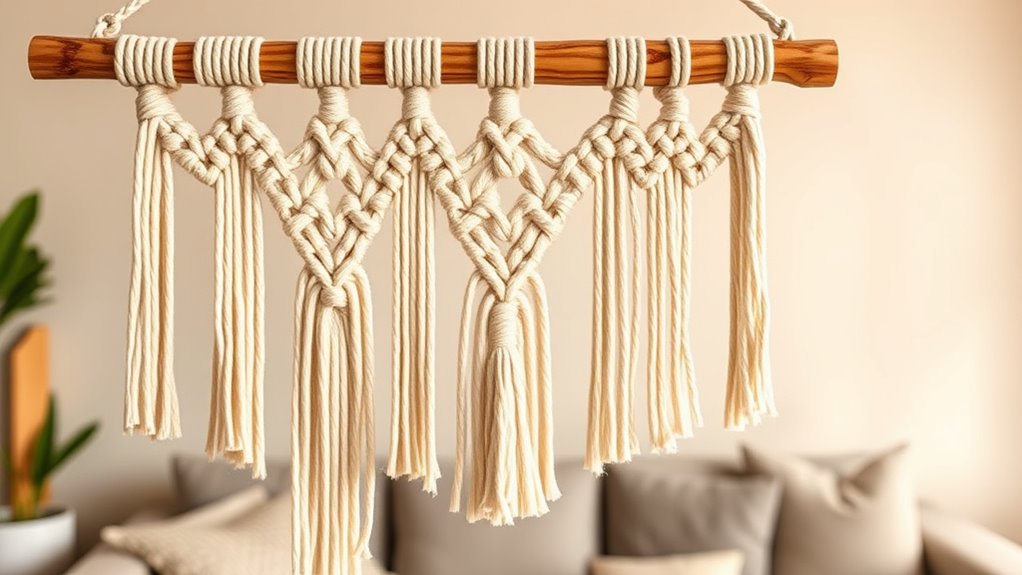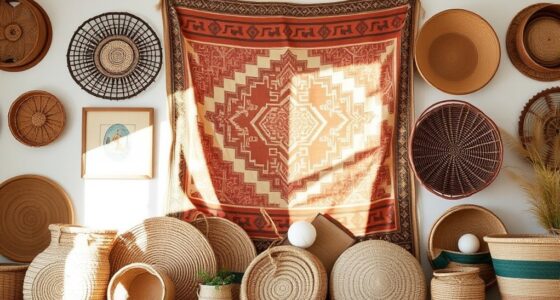To add a boho touch to your home, try creating your own macramé wall hangings DIY style. Start with basic knots like square and lark’s head using natural cotton cords and simple tools. Choose earthy or trendy colors and experiment with different textures, patterns, and sizes for a personalized look. Manage your tension for a polished finish, and add decorative elements like beads or feathers. Keep exploring, and you’ll discover even more ways to express your style.
Key Takeaways
- Use natural fibers like cotton cords and wooden dowels to create authentic, earthy boho-style wall hangings.
- Practice basic knots such as square knots and lark’s head for customizable, intricate designs.
- Measure and plan your wall space to ensure balanced, proportionate hanging placements.
- Incorporate textured elements like beads, feathers, or shells to personalize your decor.
- Follow online tutorials and free patterns to enhance skills and achieve professional-looking results.
Exploring the Origins and Modern Appeal of Macramé
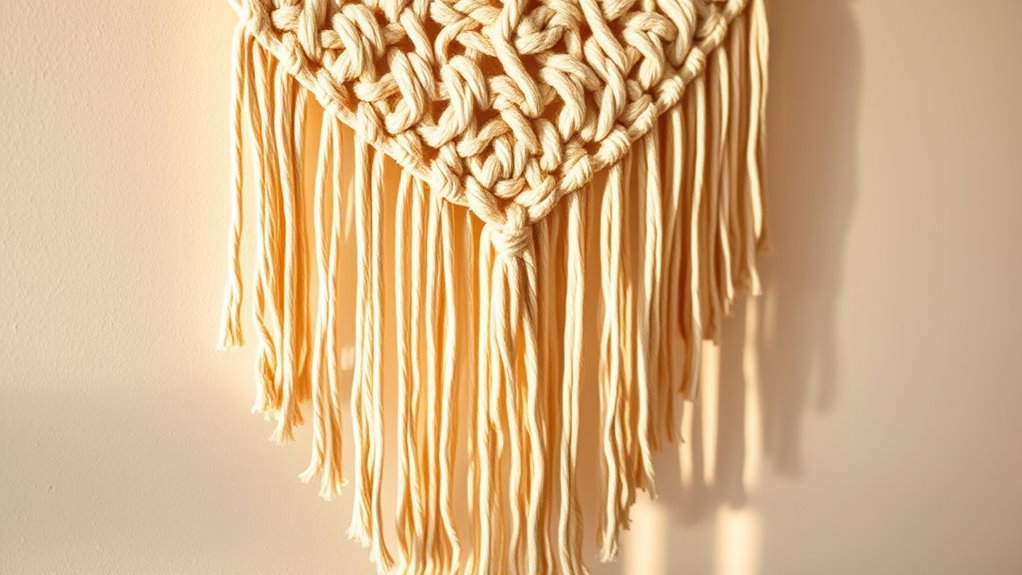
Macramé has a rich history that dates back centuries, starting as a practical textile craft used to create functional items like belts, curtains, and wall coverings. Originally popular in 13th-century Arab regions, it spread through Europe via Moorish traders and explorers. Today, macramé’s charm endures, especially in boho style decor, where its relaxed, artistic vibe fits perfectly. Modern macramé often uses natural fibers like cotton cords, giving it an authentic, earthy feel. Its appeal lies in versatility—you can craft everything from simple plant hangers to intricate wall hangings that add texture and visual interest. Whether you’re into vintage aesthetics or contemporary design, macramé offers a timeless way to personalize your space with handcrafted, natural fiber pieces that evoke a free-spirited, bohemian ambiance. Additionally, the use of sustainable materials in macramé aligns with the growing trend of eco-friendly and sustainable decor practices, emphasizing an appreciation for environmentally conscious craftsmanship. Incorporating traditional techniques can enhance the authenticity and durability of your creations, connecting you to a centuries-old craft that continues to inspire modern design. Furthermore, understanding the cultural significance of macramé in various regions can deepen your appreciation of this art form and inspire more meaningful creations. Exploring fiber sourcing and eco-friendly dyes can help you further align your projects with environmentally responsible practices.
Different Styles and Types of Macramé Wall Decor
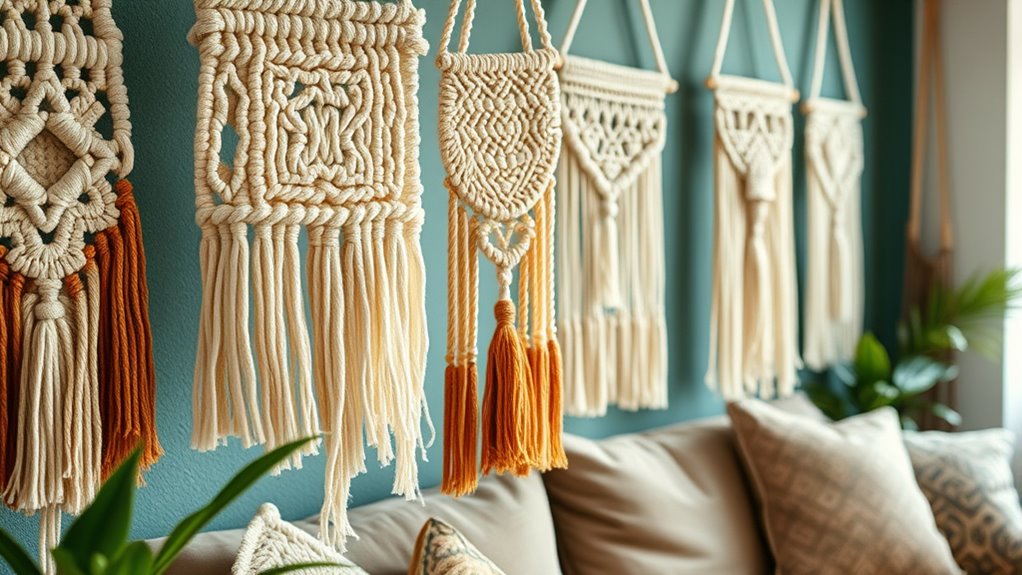
Are you curious about the diverse styles of macramé wall decor? From boho decor to contemporary wall art, there’s a style to suit every taste. Large macramé hangings often feature intricate knot patterns on wooden dowels, making them focal points in living rooms or bedrooms. Circular tapestry styles, like “Neptune,” blend modern minimalism with classic color schemes such as navy and white, creating a sleek look. Layered wall hangings combine vintage and modern elements to enhance boho-chic and eclectic interiors. Techniques vary from basic square knots to complex spiral, chevron, and fringe patterns, allowing you to express your creativity. Additionally, understanding the different styles of macramé can help you choose the perfect piece to match your decor. Exploring various knotting techniques can further expand your design options and craftsmanship. Incorporating texture variation through different knotting methods can add depth and visual interest to your wall hangings. For those interested in expanding their skills, experimenting with mixed media elements like beads or feathers can create unique textures and visual appeal. Moreover, experimenting with color schemes can help personalize your decor and complement your existing color palette. Whether you prefer minimalist designs or layered, textured pieces, these styles add personality and warmth to any space.
Essential Materials and Basic Knots for Beginners
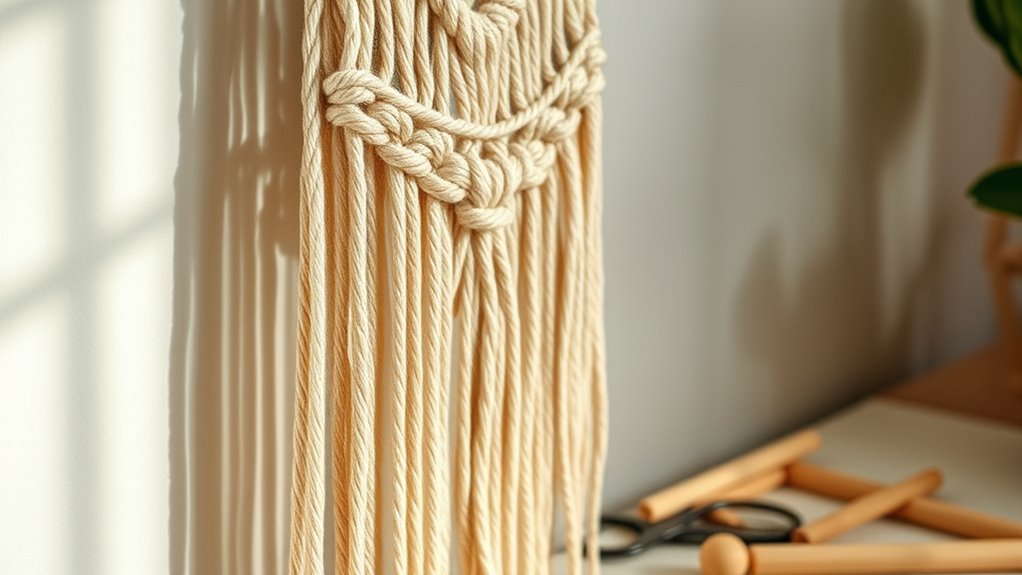
To get started, you’ll need basic materials like natural cotton or jute cords, wooden dowels or rings, scissors, and a measuring tape. Learning essential knots such as the Square Knot, Lark’s Head, and Half Hitch will help you create intricate designs. Choose the right cord length based on your project size, and start with small projects to build your skills. Additionally, understanding the properties of materials like cooking red lentils can inspire creative patterns and textures in your wall hangings. Incorporating rustic textiles into your design can enhance the boho aesthetic and add warmth to your space. Exploring soulmate angel numbers can also deepen your understanding of harmony and balance, inspiring peace in your creative process. Developing food safety awareness can ensure your materials and techniques promote a safe and durable finished piece. Considering the flat iron bike concept can inspire you to incorporate sleek and modern elements into your design, blending different styles seamlessly.
Necessary Materials Overview
Getting started with DIY macramé wall hangings requires gathering a few essential materials. First, you’ll need natural cotton cords, typically 3mm to 5mm thick, which are durable and easy to knot. A measuring tape is vital for cutting cords to the right length, usually between 3 to 6 feet depending on your design. You’ll also want wooden dowels or rings as your base to hang the cords. For cutting, keep a sharp pair of scissors handy. As a beginner, focus on mastering basic knots like the square knot, half hitch, and lark’s head knot, which form the foundation of many patterns. These essential materials and knots will set you up for creating beautiful, boho-inspired wall hangings effortlessly.
Basic Knot Techniques
Mastering a few basic knots is the foundation of creating beautiful macramé wall hangings. The three key knots for beginners are the lark’s head knot, square knot, and half hitch. The lark’s head knot is simple: fold your cord in half, loop it over the dowel, and pull the loose ends through. The square knot combines two half hitches and is versatile for patterns. Here’s a quick comparison:
| Knot Type | How to Tie | Best For |
|---|---|---|
| Lark’s Head | Fold cord, loop over dowel, pull ends through | Starting points |
| Half Hitch | Wrap cord around the dowel, pull tight | Building lines, borders |
| Square Knot | Two half hitches in sequence | Patterns, textures |
Mastering these knots opens up endless design possibilities. Additionally, understanding knot tension can help ensure your wall hanging remains secure and well-structured.
Choosing the Right Cord
Choosing the right cord is essential for creating durable and visually appealing macramé wall hangings. Opt for natural cotton cords, typically 3-6 mm in diameter, for a soft texture and longevity. Using cords made from natural materials helps guarantee your design stays sturdy and looks professional. To achieve neat knots and a polished finish, measure and cut your cords to the desired length, adding extra for knotting and fringe. Secure pre-measured cords with a knot or clamp to maintain consistent tension while working. Smooth, even-thickness cords make knotting easier and help produce a cohesive, refined look. Selecting quality cords and managing tension throughout your project guarantees a beautiful, lasting piece that enhances your boho decor. Incorporating appropriate tension during knotting ensures your design remains balanced and secure over time. Additionally, understanding the importance of personality traits like patience and attention to detail can help in mastering complex knot patterns and achieving a professional appearance. Recognizing the role of positive thinking can also motivate you to troubleshoot challenges and stay committed to your craft. Paying attention to material quality can further improve the durability and aesthetic of your finished piece. Moreover, choosing cords with consistent fiber quality can significantly impact the overall look and longevity of your wall hanging.
Step-by-Step Guide to Creating Your First Large Macramé Wall Hanging
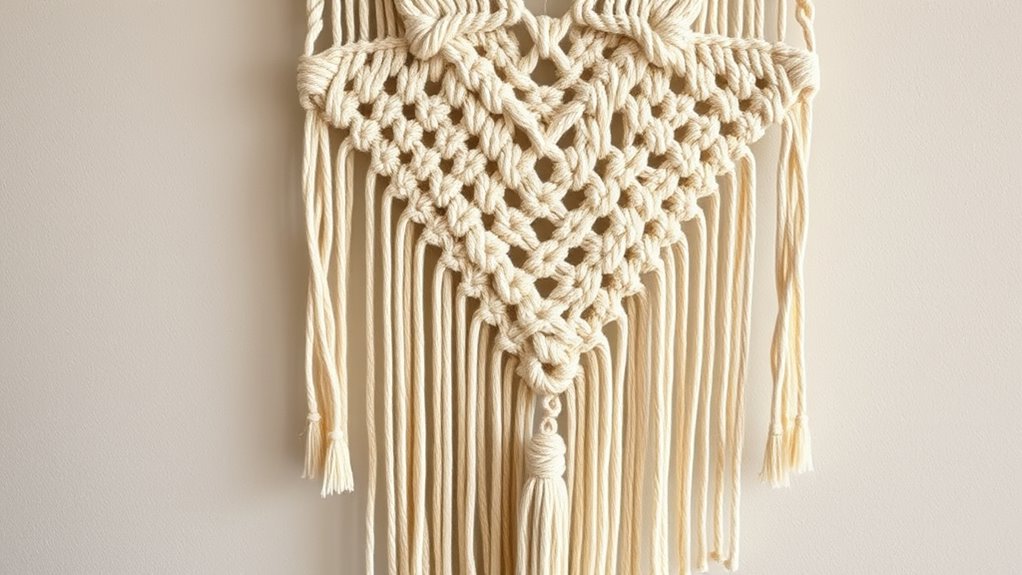
To start your big macramé wall hanging, choose a sturdy wooden dowel or branch as your base and gather cords in various lengths. Learn and practice essential knots like the lark’s head, square knot, and double half hitch to create your pattern. As you assemble, measure and mark your cords for symmetry, then trim and secure loose ends for a polished finish. Incorporating symmetry and balance into your design ensures a visually appealing and cohesive piece. Additionally, paying attention to material quality can enhance the durability and overall appearance of your wall hanging. Remember to set an intention and enjoy the creative process, which can enhance your overall satisfaction with the finished piece. Being mindful of regional resources such as tutorials and community groups can also provide additional guidance and inspiration. Recognizing the importance of emotional support during creative projects can help you stay motivated and reduce stress throughout your crafting journey.
Choosing Materials and Tools
Have you selected the right materials and tools to guarantee your macramé wall hanging turns out beautifully? Choosing quality cotton cords in your preferred color and appropriate diameter (3mm to 5mm) ensures durability and easy knotting. Gather essential tools like a wooden dowel or metal bar for hanging, scissors for trimming, and a measuring tape for accuracy. Using a sturdy surface or workspace with hooks or nails helps secure your cords during knotting. Consider adding clips or clothespins to hold cords in place, maintaining symmetry. Additionally, incorporating traditional Indigenous practices into your crafting process can deepen your connection to cultural heritage and promote sustainable, natural materials.
Basic Knot Techniques Needed
Mastering a few basic knot techniques is essential for creating a polished macramé wall hanging. The most fundamental knots are the square knot and half hitch, which form the foundation of your design. Practice these knots with scrap cords to build muscle memory before tackling your project. Using a ruler or tape measure helps maintain consistent knot spacing, ensuring a balanced, professional look. Securing your cords to a sturdy surface keeps tension steady and control high during knotting. Here’s a quick comparison:
| Knot Type | Purpose | Tips |
|---|---|---|
| Square knot | Creates a flat, secure join | Keep knots tight and even |
| Half hitch | Forms rows or decorative accents | Use a steady tension |
| Consistent knot spacing | Ensures symmetry | Measure regularly |
Master these techniques, and you’ll be well on your way to a stunning wall hanging.
Arranging and Finishing Tips
Before you start knotting, carefully measure and mark your wall space to determine the ideal size and placement for your large macramé wall hanging. This guarantees a balanced visual impact and helps you plan your layering of knot patterns and textures. As you finish, trim excess cords neatly and add a hanging loop or hook for secure display. When arranging your piece, consider these tips:
- Layer different knot patterns and textures to create depth and interest.
- Use varying fringe techniques to add a personalized touch.
- Ensure even tension throughout your design for a polished look.
Focusing on finishing details and thoughtful layering enhances your wall hanging’s overall aesthetic, making it a mesmerizing centerpiece in your home.
Incorporating Natural and Trendy Colors Into Your Designs
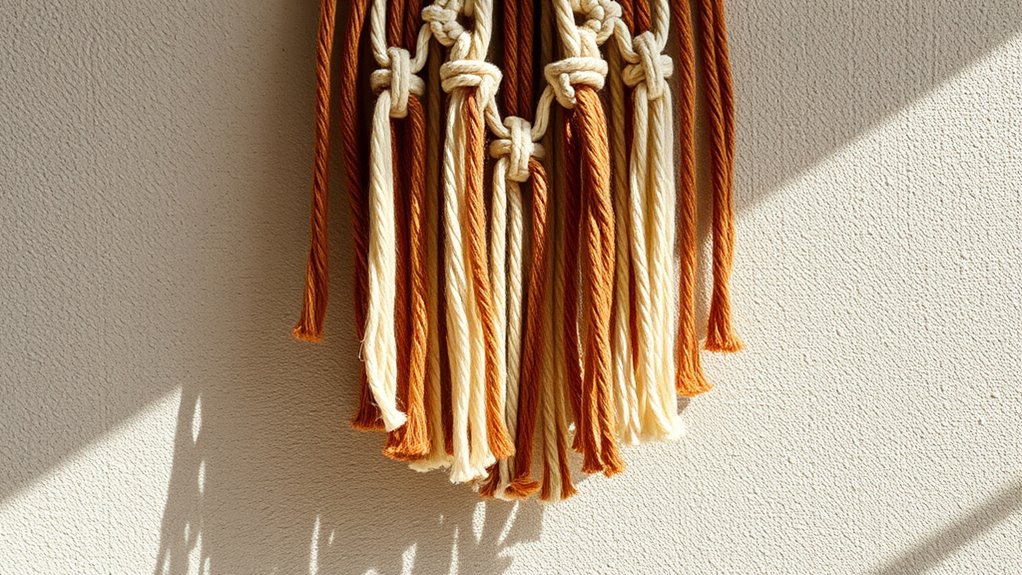
Incorporating natural and trendy colors into your macramé wall hangings can transform your designs into versatile and visually appealing pieces. Natural colors like beige, taupe, and earthy greens create a calming, boho-inspired aesthetic that pairs well with organic imagery. Trend hues such as mustard yellow, terracotta, and navy blue add vibrant contrast, elevating your piece’s overall appeal. Using dip-dye techniques with gradients of natural dyes can evoke scenes like sunsets or ocean horizons, adding depth and visual interest. A palette of soft, muted tones allows your macramé to blend seamlessly with various interior styles, from minimalist to eclectic. Combining these trend hues with natural fibers and textures results in decor that feels both contemporary and earthy, perfect for a stylish, cozy space.
Creative Ideas for DIY Macramé Wall Art and Functional Pieces
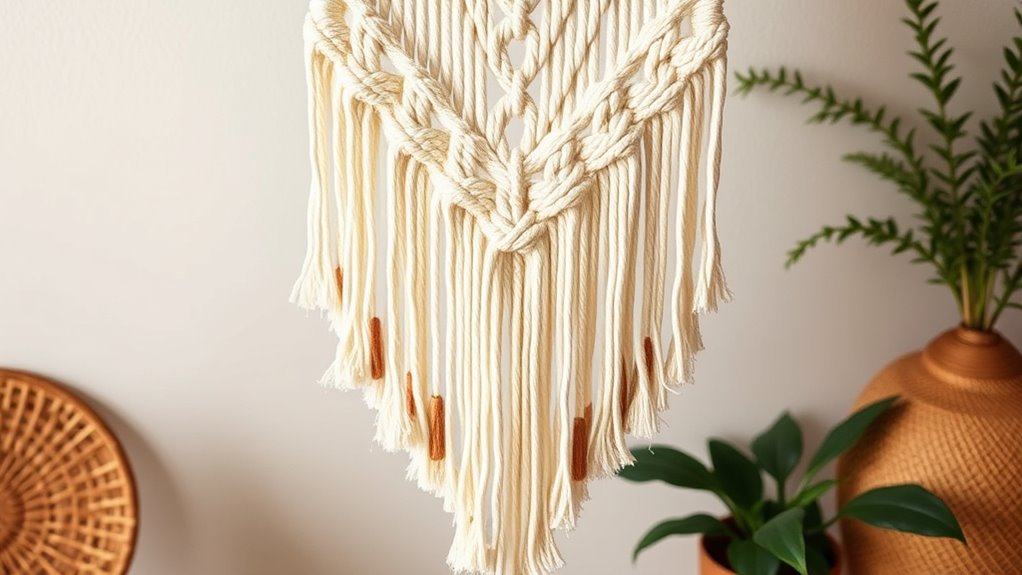
Creating DIY macramé wall art and functional pieces allows you to personalize your space while exploring your creativity. You can craft eye-catching Macramé Wall hangings that serve as statement pieces or functional items like plant hangers and key holders. To enhance your home decor, experiment with different textures, geometric motifs, and layered designs that reflect your personal style. Incorporate elements such as wooden dowels, rings, or frames to add structure and variety. With numerous free patterns and tutorials online, even beginners can create large, intricate pieces. Remember, crafting your own macramé not only adds a boho touch to your interior but also offers a therapeutic, budget-friendly way to develop new skills and make your space uniquely yours.
Tips for Customizing and Personalizing Your Macramé Projects
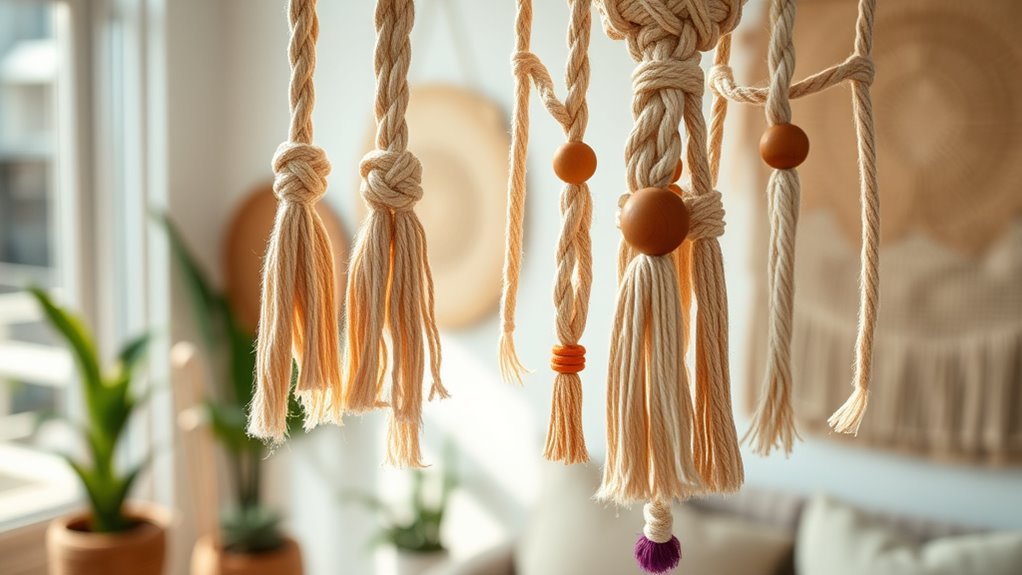
Ever wonder how to make your macramé project truly stand out? One way is by adding personalized charms, beads, or natural elements like feathers and shells to give it a bespoke touch. These details reflect your personality and style, making your piece unique. Experiment with different dye techniques, such as dip-dye or ombré, to customize your color palette and create distinctive visual effects. Use a variety of fiber textures and knot styles to develop patterns that match your decor theme. Be sure to measure and plan your project carefully, adjusting length and design elements to fit your wall space perfectly. Finally, consider framing or mounting your finished work with custom hardware to enhance its appeal and seamlessly integrate it into your interior aesthetic.
Resources and Inspiration for Continuing Your Macramé Crafting Journey

To keep your macramé skills growing, exploring various resources and sources of inspiration can make a big difference. Platforms like SkillShare and YouTube offer extensive tutorials suitable for all skill levels, helping you master new knots and techniques. Many DIY home bloggers, such as Meredith, share step-by-step guides and tips to spark your creativity and improve your craftsmanship. Online communities and social media groups provide a supportive space where you can share your projects, troubleshoot issues, and exchange ideas with fellow enthusiasts. These resources include free patterns, video demonstrations, and detailed instructions that cover a wide range of styles. By engaging with these tools, you’ll stay inspired and continuously refine your macramé craft.
Frequently Asked Questions
How Do I Choose the Right Size for My Wall Hanging?
When choosing the right size for your wall hanging, consider the wall space and furniture nearby. Measure the area where you want to hang it, leaving some breathing room around the edges. If your wall is large, go bigger to make a statement; for smaller spaces, a more modest piece works best. Think about proportion and balance to guarantee your wall hanging complements your room without overwhelming it.
Can I Use Synthetic or Alternative Materials Instead of Cotton?
Using synthetic or alternative materials is like trying a new flavor—exciting but different from cotton. You can absolutely use them for your wall hanging; they often cost less and come in vibrant colors. Just keep in mind that some synthetics may be less breathable or durable. Experiment with different textures and finishes to find what fits your style and needs best. It’s your creative project, so have fun!
What Are Some Common Mistakes to Avoid in Macramé Projects?
When tackling macramé projects, you want to avoid common mistakes like using the wrong cord length, which can make your piece uneven. Don’t rush through knotting; patience guarantees neatness and consistency. Also, steer clear of overly tight knots that can distort your design. Keep tension even, double-check your pattern, and practice basic knots. With attention to detail, you’ll create beautiful, professional-looking macramé that adds a boho charm to your space.
How Do I Hang and Secure My Finished Wall Hanging Properly?
To hang and secure your wall hanging properly, start by choosing a sturdy wall hook or rod that can support its weight. Make sure your wall anchors are secure, especially if hanging on drywall. Use clear picture hangers or removable hooks to avoid damage. Adjust the placement as needed to keep it level, and double-check that all knots are tight to prevent slipping. This way, your wall hanging stays secure and looking great.
Are There Eco-Friendly or Sustainable Options for Macramé Supplies?
You’re wondering if eco-friendly options exist for macramé supplies. Yes, you can choose organic cotton, hemp, or jute cords, which are sustainable and biodegradable. Look for suppliers that prioritize eco-conscious practices, such as using recycled or natural dyes. By selecting these materials, you help reduce environmental impact while creating beautiful, boho-style wall hangings. It’s a simple way to enjoy your craft and support sustainability at the same time.
Conclusion
Now that you’ve learned the basics, your space can transform from plain to boho chic. Imagine the earthy warmth of natural fibers against sleek modern furniture—an artful contrast that reflects your creativity. With each knot, you’re not just making decor, but crafting a personalized haven. Embrace the process, let your imagination run wild, and watch your DIY macramé creations become the stunning focal points that turn your home into a stylish sanctuary.
